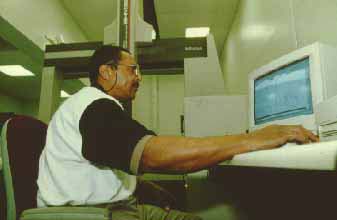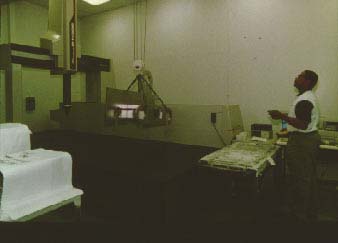Inspection Method Beefs Up Plant Throughput and Yield
A semiconductor processing equipment manufacturer adopts a CNC/CMM system from Mitutoyo and attains plantwide production benefits.
Plant production personnel at CDS Leopold (San Carlos, CA) got unexpected improvements in overall machining throughput and yield — just from a change in their method of inspection. When the company, which manufactures semiconductor processing equipment parts, switched from a manual CMM to an advanced computer numerically controlled measuring method (CNC/CMM), it not only achieved a tenfold inspection throughput improvement, but also got the benefit of additional plantwide perks.
Now the company enjoys increased throughput and yield because inspection data is fed back to the plant faster and historical process capability data on specific parts and machines is captured as well.

A Change for the Better
The CNC/CMM and its sophisticated high-level software program are linked to AutoCAD and the plantwide computer network at CDS Leopold. Production personnel use the data to precisely match jobs to machines that have performed most efficiently on similar tasks. The result? Better process control and fewer production interruptions — enabling the company to meet growing customer demands for JIT deliveries.
"We run 70 to 100 different parts on a normal day with hundreds to thousands of features that often require 100% first-article inspection," says Bob Esperanza, QA manager. "The new CNC/CMM compiles real-time data and provides benchmarks for evaluating individual machine performance. Bottom line: better capacity utilization and quicker turnaround."
The ‘Secret Weapon'
The key to success for Esperanza is the BHN 1325 CNC/CMM, which is equipped with CADMeasure 6000 software, both from Mitutoyo America Corp. (MTI; Aurora, IL). The combination of machine and software enables the manufacturer to reverse-engineer inspection fixtures for both production and inspection. The CNC/CMM offers 0.00002 in. (0.0005 mm) resolution; X-axis range of 0-52 in., Y-axis range of 0-100 in., and Z-axis range of 0-40 in.; 17 in./s (430 mm/s) maximum drive speed, and 6,600 lbs maximum workpiece weight.
"Rather than turning the work over to a draftsman, we use the BHN 1325 CNC/CMM to generate a CAD designed fixture which matches the part," adds Esperanza. "It's faster and more accurate."

Esperanza compared three CMMs before choosing the Mitutoyo machine. He found the BHN 1325 CNC/CMM (with CADMeasure 6000 software) appealing for various reasons. One important plus that helped Esperanza make his choice was the fact that comparable machines didn't have the higher level language. "To buy UNIX-type software for the same capabilities costs three to four times more. The Mitutoyo CADMeasure 6000 software is a standard MTI offering, so you get product support and training from a single source," he explains.
It also is designed to provide true multitasking, high-speed capability with full 32-bit operation. Key features include quick extraction of measurement points (x, y, z, i, j, k) from nominal NURBS curves and surfaces, multiformat data import and export capabilities, and the ability to harness the full power of AutoCAD.
In addition, MTI Corp. hooked up the unit's Windows NT operating system to the company's network and trained three inspectors for a week. During that time, the operators learned how to transfer electronic drawings from AutoCAD to the resident CAD database and to create and add programs with the software's high-level language.
High-Tech Inspection
Among the benefits CDS Leopold is reaping is the ability for inspectors to create part programs either online or offline. If done offline, they can develop routines during the design phase, prior to actual manufacturing, and can use the CMM without tying it up in the traditional teach/learn mode. And when inspectors perform first-article inspection, they simply load the part onto the CMM, where they retrieve and execute the part program.
If an error occurs, inspectors immediately send an e-mail the machinist, who's alerted by a warning bell at his station that prompts him to check e-mail and adjust the machine accordingly. At the same time, in the CMM room, inspectors insert a new macro routine (which can be instructions for the CNC/CMM to re-measure the feature in question after correction) into the program without interrupting the ongoing inspection. After first-article inspection, typically few renewed inspection passes are necessary; they are performed mainly to assess process capability and statistical analysis.

To design a fixture, inspectors work in AutoCAD for NT and the CMM CAD functions. That way, each fixture is customized to the part's complexity. And traditional CAD functions such as drawing, editing, layering, panning, and zooming are executed with standard system hardware (i.e., monitor, mouse, plotter, printer, and digitizer) that's fully supported by CADMeasure 6000 software.
Mitutoyo America (MTI) Corp., 945 Corporate Blvd., Aurora, IL 60504. Tel: 630-820-9666; Fax: 630-820-7403.
Edited by Nancy Katz
